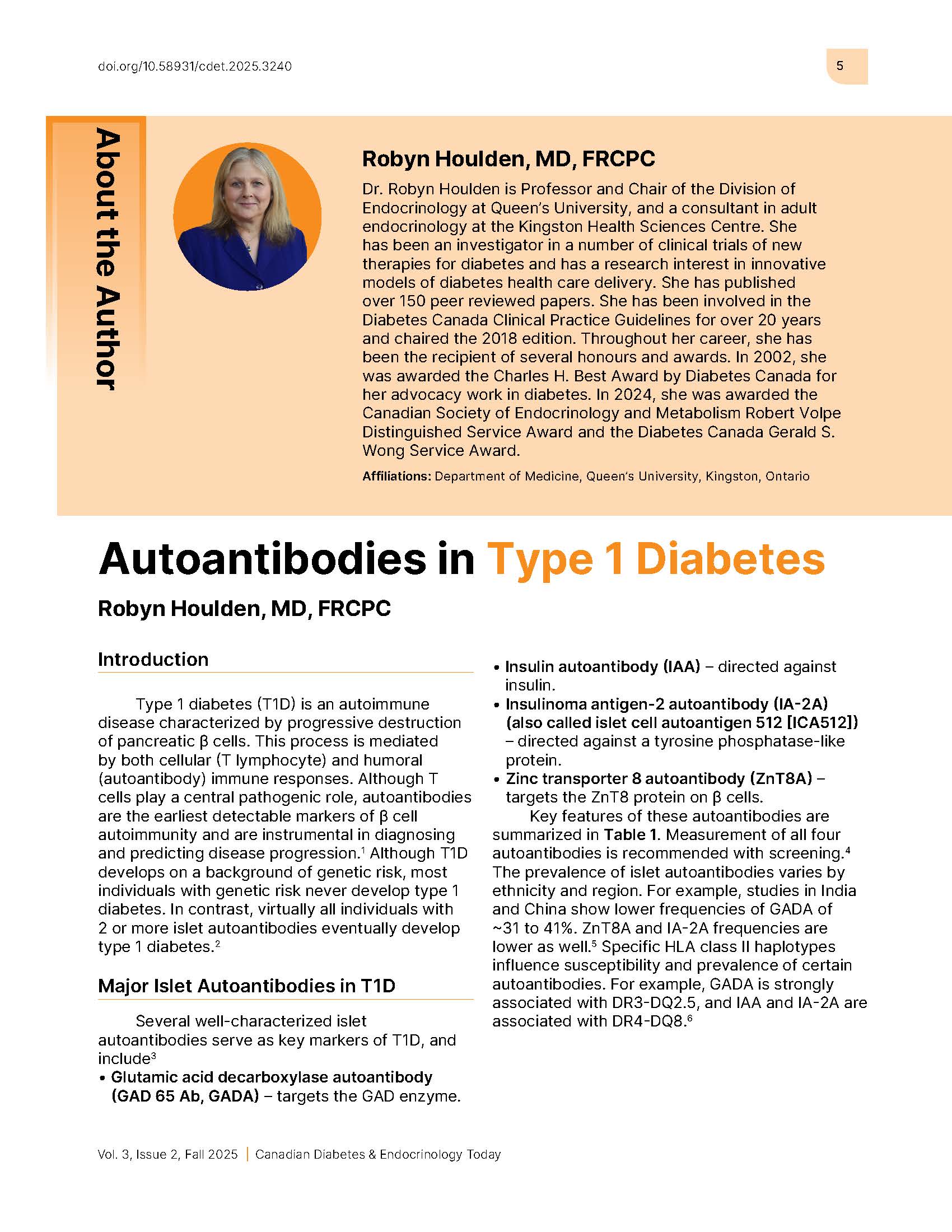Autoantibodies in Type 1 Diabetes
DOI:
https://doi.org/10.58931/cdet.2025.3240Abstract
Type 1 diabetes (T1D) is an autoimmune disease characterized by progressive destruction of pancreatic β cells. This process is mediated by both cellular (T lymphocyte) and humoral (autoantibody) immune responses. Although T cells play a central pathogenic role, autoantibodies are the earliest detectable markers of β cell autoimmunity and are instrumental in diagnosing and predicting disease progression. Although T1D develops on a background of genetic risk, most individuals with genetic risk never develop type 1 diabetes. In contrast, virtually all individuals with 2 or more islet autoantibodies eventually develop type 1 diabetes.
References
Wasserfall CH, Atkinson MA. Autoantibody markers for the diagnosis and prediction of type 1 diabetes. Autoimmun Rev. 2006;5(6):424-8. DOI: https://doi.org/10.1016/j.autrev.2005.12.002
Insel RA, Dunne JL, Atkinson MA, Chiang JL, et al. Staging presymptomatic type 1 diabetes: A scientific statement of JDRF, the Endocrine Society, and the American Diabetes Association. Diabetes Care 2015;38(10):1964–1974. DOI: https://doi.org/10.2337/dc15-1419
Bonifacio E, Achenbach P. Birth and coming of age of islet autoantibodies. Clin Exp Immunol. 2019;198(3):294-305. DOI: https://doi.org/10.1111/cei.13360
ElSayed NA, Aleppo G, Aroda VR, et al. American Diabetes Association; 2. Classification and Diagnosis of Diabetes: Standards of Care in Diabetes—2023. Diabetes Care 2023;46 (Supplement 1): S19–S40. DOI: https://doi.org/10.2337/dc23-S002
Singh S, Usha, Singh G, Agrawal NK, et al. Prevalence of autoantibodies and HLA DR, DQ in type 1 diabetes mellitus. J Clin Diagn Res 2016;10(7):EC09-13. DOI: https://doi.org/10.7860/JCDR/2016/18657.8163
Berryman MA, Ilonen J, Triplett EW, et al. Important denominator between autoimmune comorbidities: a review of class II HLA, autoimmune disease, and the gut. Front Immunol 2023;14:1270488. DOI: https://doi.org/10.3389/fimmu.2023.1270488
Bingley PJ, Wherrett DK, Shultz A, et al. Type 1 Diabetes TrialNet: A multifaceted approach to bringing disease-modifying therapy to clinical use in type 1 diabetes. Diabetes Care 2018;41(4):653-661. DOI: https://doi.org/10.2337/dc17-0806
Steck AK, Dong F, Frahnert B, et al. Predicting progression to diabetes in islet autoantibody positive children. Journal of Autoimmunity 2018;90:59-63. DOI: https://doi.org/10.1016/j.jaut.2018.01.006
Holt RIG, DeVries JH, Hess-Fischl Am et al. The management of type 1 diabetes in adults. A consensus report by the American Diabetes Association (ADA) and the European Association of the Study of Diabetes (EAS). Diabetologia 2021;64(12):2609-2652. DOI: https://doi.org/10.1007/s00125-021-05568-3
Tiberti C, Buzzetti R, Anastasi E, et al. Autoantibody negative new onset type 1 diabetic patients lacking high risk HLA alleles in a caucasian population: are these type 1b diabetes cases? Diabetes Metab Res Rev 2000;16(1):8-14 DOI: https://doi.org/10.1002/(SICI)1520-7560(200001/02)16:1<8::AID-DMRR77>3.3.CO;2-K
Phillip M, Achenbach P, Addala A, et al. Consensus guidance for monitoring individuals with islet autoantibody-positive pre-stage 3 type 1 diabetes. Diabetes Care 2024;47(8):1276-1298.
Tridgell DM, Spiekerman C, Wang RS, et al. Interaction of onset and duration of diabetes on the percent of GAD and IA-2 antibody-positive subjects in the type 1 diabetes genetics consortium database. Diabetes Care 2011;34(4):988-993. DOI: https://doi.org/10.2337/dc10-1903
Usher-Smith JA, Thompson M, Ercole A, et al. Variations between countries in the frequency of diabetic ketoacidosis at first presentation of type 1 diabetes in children: a systematic review. Diabetologia 2012;55(11):2878-94. DOI: https://doi.org/10.1007/s00125-012-2690-2
Shill JE. Diabetic ketoacidosis. In: Ferri FF, ed. Ferri’s Clinical Advisor 2023. Elsevier, Inc; 2023:510-512.e1.
Katte JC, McDonald TJ, Sobngwi E, Jones AG. The phenotype of type 1 diabetes in sub-Saharan Africa. Front Public Health. 2023;27;11:1014626. DOI: https://doi.org/10.3389/fpubh.2023.1014626
Sims EK, Besser REJ, Dayan C et al. Screening for Type 1 Diabetes in the General Population: A Status Report and Perspective. Diabetes 2022;71(4):610–623. DOI: https://doi.org/10.2337/dbi20-0054
Smith LB, Liu X, Johson SB, et al. Family adjustment to diabetes diagnosis in children: can participation in a study on type 1 diabetes genetic risk be helpful? Pediatr Diabetes 2018;19:1025-1033. DOI: https://doi.org/10.1111/pedi.12674
Herold KC, Bundy BN, Long SA, et al. An anti-CD3 antibody, teplizumab, in relatives at risk for type 1 diabetes. N Engl J Med 2019;381:603-613. DOI: https://doi.org/10.1056/NEJMoa1902226
Hummel S, Carl J, Friedl N et al. Children diagnosed with presymptomatic type 1 diabetes through public health screening have milder diabetes at clinical manifestation. Diabetologia 2023;66:1633-1642. DOI: https://doi.org/10.1007/s00125-023-05953-0
Leichter SB, Felton JL, Rasmussen CG, et al. Establishing screening programs for presymptomatic type 1 diabetes: practical guidance for diabetes care providers, J Clin Endocrinol Metab 2025;110(8):2371–2382. DOI: https://doi.org/10.1210/clinem/dgaf194
Jacobsen LM, Felton JL, Nathan BM, et al. Type 1 Diabetes TrialNet: leading the charge in disease prediction, prevention, and immunotherapeutic mechanistic understanding. Diabetes Care 2025;48(7):1112–1124. DOI: https://doi.org/10.2337/dc24-2908
American Diabetes Association Professional Practice Committee. 2. Diagnosis and Classification of Diabetes: Standards of Care in Diabetes-2025. Diabetes Care. 2025 Jan 1;48 (Suppl 1):S27-S49. DOI: https://doi.org/10.2337/dc25-S002
Eisenbarth GS. Banting lecture 2009: an unfinished journey: molecular pathogenesis to prevention of type 1A diabetes. Diabetes 2010;59(4):759-74. DOI: https://doi.org/10.2337/db09-1855

Downloads
Published
How to Cite
Issue
Section
License
Copyright (c) 2025 Canadian Diabetes & Endocrinology Today

This work is licensed under a Creative Commons Attribution-NonCommercial-NoDerivatives 4.0 International License.
